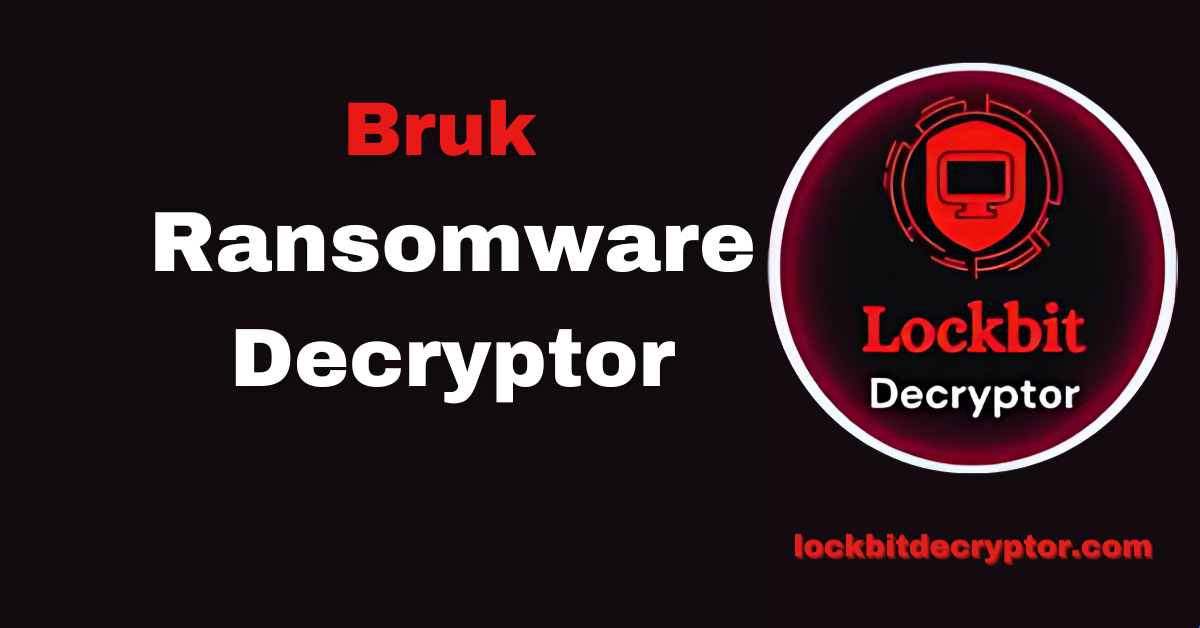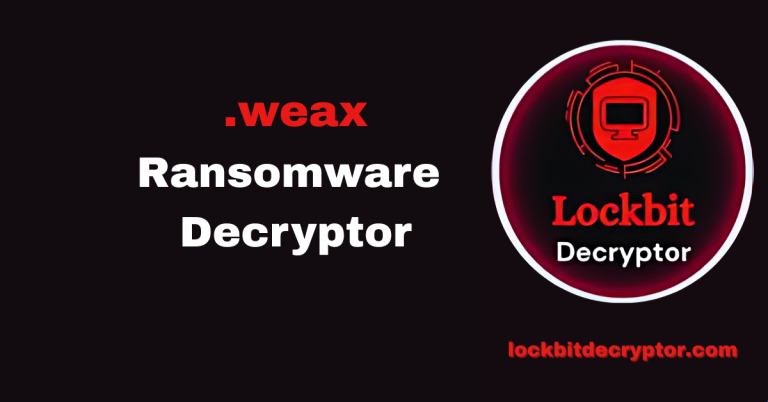How to Decrypt Bruk Ransomware (.bruk) and Recover Encrypted Files?
Expert-Built Bruk Decryptor for Fast Recovery
Bruk ransomware is a dangerous file-locking malware that encrypts valuable data and demands ransom for decryption. Our cybersecurity researchers reverse-engineered its encryption layers and designed a professional decryptor that offers stable and accurate recovery. The tool is compatible with Windows and supports enterprise-grade workloads, ensuring safe restoration without paying criminals.
Related article: How to Remove LockSprut Ransomware and Restore (.rupy3xz1) Encrypted Files?
How the Bruk Decryption Engine Works?
Our decryptor was engineered to safely reverse Bruk’s cryptographic logic. It verifies victim-specific IDs, isolates corrupted sectors, and then attempts controlled decryption without altering original files. The solution leverages blockchain-backed integrity checks to ensure that recovered files remain authentic and unmodified.
Also read: How to Decrypt (.DarkRuss_CyberVolk) Files Locked by DarkNetRuss Ransomware?
What Immediate Actions Victims Should Take?
Once Bruk ransomware strikes, swift and calculated actions matter most. Disconnecting systems, preserving evidence, and avoiding risky DIY decryption attempts are essential for data recovery.
First Response After Infection
- Isolate the infected device from your network to stop lateral movement.
- Keep ransom notes and encrypted files untouched, as they are crucial for analysis.
- Do not reboot systems, since additional scripts may trigger.
- Reach out to ransomware response experts who can safely evaluate your case.
Data Recovery and Decryption Options for Bruk
There are several paths to attempt data recovery after a Bruk infection. These range from free community-driven decryptors for flawed variants, to professional decryptors built by cybersecurity researchers.
Free Approaches
- Backup Restoration – Victims with unaffected offsite or offline backups can fully restore systems by wiping infected machines and reinstalling clean images.
- Shadow Copies (Rare Cases) – If Bruk fails to delete shadow copies, recovery tools may restore files. However, in most observed attacks, these are erased.
- Community Tools and Free Recovery Options
For many ransomware families, community-driven initiatives such as NoMoreRansom.org or independent security researchers provide decryption utilities that can restore data without paying criminals.
Some older Bruk variants may be susceptible to file restoration techniques if weaknesses are identified in the encryption scheme. In addition, forensic tools can sometimes recover partial data from unencrypted system caches, shadow copies, or temporary files that were not completely deleted during the attack.
Security forums and trusted cybersecurity vendors occasionally release targeted decryptors for specific ransomware strains. Keeping backups of ransom notes, encrypted samples, and system logs can significantly improve the chances of recovery when such tools emerge.
Paid Methods
- Paying the Attackers – Bruk operators demand Bitcoin payments for decryption. However, there is no guarantee of receiving a working key. Many victims lose money without recovery.
- Third-Party Negotiators – Some victims hire professional negotiators to lower ransom demands. This process carries high costs and mixed success rates.
- Our Advanced Bruk Decryptor – Developed by our team, this tool safely decrypts locked files by exploiting structural flaws in Bruk’s cryptographic operations. It uses hybrid AI + blockchain processing, ensuring precision without additional risks.
How to Use Our Bruk Decryptor?
- Download and install the decryptor on a clean, isolated system.
- Launch the tool with administrator privileges for full functionality.
- Upload a sample of your encrypted files along with the ransom note (README.TXT).
- Enter the victim ID from the ransom note to align the decryption process.
- Begin the scan — the tool performs a read-only analysis before applying changes.
- Initiate decryption — files are restored to their original format, with a detailed log provided.
Also read: How to Decrypt (.solutionwehave247) Files Encrypted by SolutionWeHave Ransomware?
Key Features of Our Bruk Decryptor
- Victim ID Matching – Uses ransom note identifiers to target your specific encryption case.
- AI-Powered Integrity Checks – Validates decrypted files with blockchain-backed verification.
- Hybrid Cloud + Local Operation – Works both online for fast validation and offline for secure environments.
- Safe Execution – Read-only scans prevent accidental data corruption before decryption.
- Universal Mode – Capable of handling cases where ransom notes are missing or damaged.
- Enterprise-Ready – Optimized for high-volume workloads, including corporate file servers.
Technical Profile of Bruk Ransomware
Bruk is part of the crypto-ransomware family. It encrypts data using strong algorithms and renames files with the .bruk extension along with a victim-specific ID.
File Behavior and Ransom Note
Encrypted files appear as “example.docx.{victim_ID}.bruk.” The ransom note “README.TXT” claims that only the attackers can restore files. Victims are instructed to contact bruklin777@cyberfear.com within 24 hours.
Tactics, Techniques, and Procedures (TTPs)
Bruk actors employ common yet effective ransomware strategies:
- Initial Access: Spam emails with malicious attachments, fake software cracks, and trojan loaders.
- Persistence: Registry modifications and scheduled tasks ensure the malware restarts.
- Defense Evasion: Use of obfuscation and disabling of antivirus tools.
- Lateral Movement: Exploiting SMB shares and RDP credentials to spread across networks.
- Data Encryption: Employs hybrid symmetric and asymmetric cryptography.
- Impact: Deletes shadow copies and blocks recovery methods.
Attacker Tools Observed
Email Phishing Kits
Bruk operators rely heavily on phishing campaigns to deliver their ransomware payloads. Pre-built email phishing kits are used to automate the creation and sending of fraudulent emails that mimic legitimate senders. These kits often include ready-made templates, spoofing tools, and payload embedding functions that hide malicious executables inside documents (like Word, PDF, or OneNote). Once the victim clicks an attachment or link, the ransomware installer is silently deployed. Attackers prefer these kits because they lower the barrier to entry—someone with minimal technical skill can still distribute ransomware at scale.
Mimikatz and Other Credential Harvesters
Once inside a network, attackers must escalate privileges and move laterally. Mimikatz is the go-to tool for credential harvesting, capable of extracting plaintext passwords, hashes, and Kerberos tickets directly from system memory. Cybercriminals often pair Mimikatz with utilities like LaZagne or built-in Windows commands to pull credentials stored in browsers or local databases. With administrator rights, the Bruk operators can access shared drives, deploy ransomware to other systems, and disable defenses—making Mimikatz a cornerstone of lateral spread in corporate environments.
RClone and Mega Uploaders
Before encryption, Bruk actors often engage in double extortion, stealing sensitive files to threaten public leaks. Tools like RClone and Mega uploaders are lightweight, command-line programs that sync local files with cloud storage services such as Google Drive, OneDrive, or Mega.nz. These utilities are trusted by system administrators, so their network traffic often bypasses security monitoring. Attackers configure them with stolen credentials or API keys, enabling quick bulk uploads of corporate data. Once exfiltration is complete, the files are encrypted locally, leaving victims with the impossible choice of paying to prevent a leak or facing public exposure.
PowerShell Scripts
To ensure victims cannot simply roll back their systems, Bruk ransomware deletes Windows Volume Shadow Copies, which are automatic system backups. Attackers use custom PowerShell scripts that issue commands like:
vssadmin delete shadows /all /quiet
or leverage WMIC (Windows Management Instrumentation Command-line) to achieve the same outcome. PowerShell offers flexibility: it can run silently, embed obfuscated code, and chain multiple destructive commands together. In Bruk campaigns, these scripts also disable built-in recovery features, stop security services, and sometimes prepare systems for encryption by closing processes that lock files.
Known Indicators of Compromise (IOCs)
- File Extensions: .{victim_ID}.bruk
- Ransom Note: README.TXT in affected directories
- Email Contact: bruklin777@cyberfear.com
- Processes: Suspicious execution from %AppData% and Temp directories
- Detection Names: Microsoft (Trojan:Win32/Wacatac.B!ml), Kaspersky (HEUR:Trojan-Ransom.Win32.Generic)
Geographic and Sector-Based Impact
Bruk infections have been detected globally, though some countries and industries are hit more heavily than others.
Countries Most Affected
Organizations Commonly Targeted
Timeline of Bruk Campaigns
Best Security Measures Against Bruk
Protecting against ransomware requires vigilance and layered defenses. Always download software from trusted sources, enable multi-factor authentication, and maintain offline backups. Deploying updated antivirus solutions and continuous monitoring reduces the risk of infection.
Bruk Ransomware Note Analysis
The ransom note “README.TXT” contains classic extortion language. Victims are warned not to rename files or use third-party decryptors. Attackers offer to decrypt one file as proof and demand payment in Bitcoin for the full decryptor.
Excerpt from the ransom note:
YOUR FILES ARE ENCRYPTED
All your files have been encrypted due to weak security.
Only we can recover your files. You have 24 hours to contact us. To contact us, you need to write to the mailbox below.
To make sure we have a decryptor and it works, you can send an email to:
bruklin777@cyberfear.com and decrypt one file for free.
We accept simple files as a test. They do not have to be important.Warning.
* Do not rename your encrypted files.
* Do not try to decrypt your data with third-party programs, it may cause irreversible data loss.
* Decrypting files with third-party programs may result in higher prices (they add their fees to ours) or you may become a victim of fraud.* Do not contact file recovery companies. Negotiate on your own. No one but us can get your files back to you. We will offer to check your files as proof.
If you contact a file recovery company, they will contact us. This will cost you dearly. Because such companies take commissions.
We accept Bitcoin cryptocurrency for payment.Email us at:
bruklin777@cyberfear.com
Conclusion: Recovering from Bruk Without Paying Criminals
Bruk ransomware is a severe threat that can paralyze businesses and individuals. While paying the ransom is tempting, it rarely guarantees recovery and only funds cybercrime. Victims should focus on professional decryption tools, safe recovery practices, and strengthening security posture for the future.
Frequently Asked Questions
Contact Us To Purchase The Bruk Decryptor Tool







2 Comments